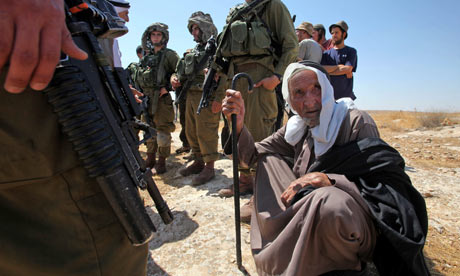Israel's ministry of defence has rejected an appeal to save eight West Bank Palestinian villages in the southern Hebron hills that are slated for demolition to make way for an Israeli Defence Forces (IDF) training ground.
Defence minister Ehud Barak reiterated to Israel's high court on Sunday the state's position that the Palestinian villagers are not full-time residents of the land and should be removed to the nearby town of Yatta.
They would be allowed to return to tend their land and graze sheep at weekends, Jewish holidays and two one- month stints every year when soldiers do not train.
Around 1,500 people live in Majaz, Tabban, Sfai, Fakheit, Halaweh, Mirkez, Jinba and Kharuba. They are mostly farmers who live from the rearing and selling of sheep and goats.
For these villagers, leaving the expansive Hebron hills is simply not an option.
"We have no choice but to be here, this is how we were raised and this is how we live," said one shepherd from Khirbat Zanuta, another village in the area whose homes, sheep pens and water cisterns have all been issued with demolition orders. "The only thing we know how to do is raise sheep. We can only do that here."
Based on the testimonies of local informers, Israel argues that these communities do not genuinely live on the land but are based in nearby towns. A state investigation conducted in 2000 found "there were no permanent residents in the area".
The villagers, supported by the evidence of Israel archaeologists and human rights groups, say their families have farmed the area since the late 1800s, certainly long before Israel occupied the West Bank in 1967.
For generations, these communities lived in caves tucked into the barren hillsides, protected from the wind, rain and summer heat. When these caves began to collapse in the late 90s, families gradually abandoned their traditional homes and built their current ones, patchwork constructions of improvised stonewalls, wooden struts and tarpaulin.
The structures were built without Israeli permission on land that Israel declared an "open firing zone" in the 1970s. As they stand in Area C, the 64% of the West Bank under full Israeli control, the state has ordered that they be demolished.
However, B'Tselem, an Israeli rights group, has argued that Israel has no legal justification to evict these villagers. "International human rights law demands a pressing military need. Training soldiers is not a pressing need. Israel can't simply take any land it wishes on this basis," said Sarit Michaeli, the group's spokesperson.
In her case to the high court, Hila Gurani, the state's attorney, wrote that the second intifada and the second Lebanon war exposed gaps in IDF preparation that requires more extensive training in firing zones, which the illegal Hebron residents are preventing. She also suggested that if the current residents were allowed to remain, they would gather intelligence on IDF methods or collect any weapons and equipment soldiers might leave behind to use in terrorist activity.
The court has given the Hebron villagers until 2 August to present their response – the latest round in a battle they have been fighting since 1999. Lawyers with the Association for Civil Rights in Israel advising them have vowed to pursue the case.


